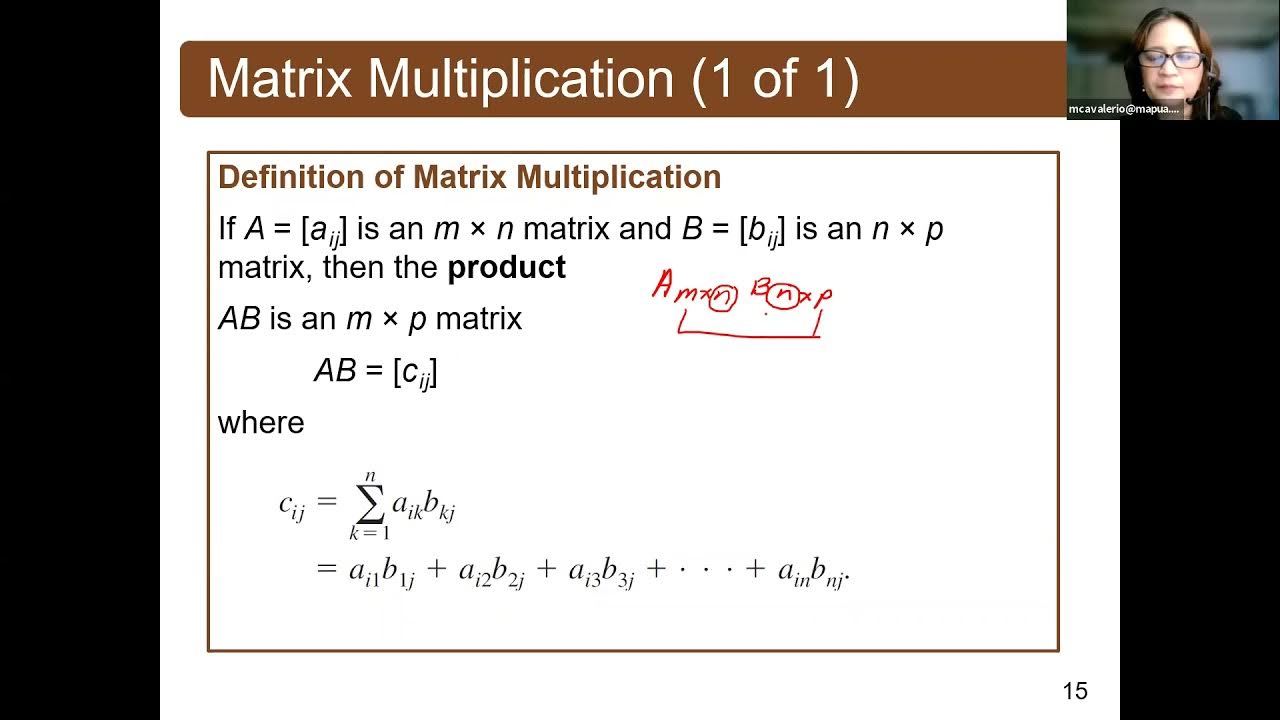2.2 Properties of Matrix Operations
Summary
TLDRThis lesson covers the properties of matrix operations, including addition, scalar multiplication, and matrix multiplication, emphasizing their associative and commutative characteristics. Key concepts such as the identity matrix and zero matrix are explained, alongside examples to illustrate these properties in practice. The lesson also introduces the transpose of a matrix, demonstrating its role in producing symmetric matrices when multiplied by the original matrix. The importance of these properties is highlighted, providing a foundational understanding crucial for advanced matrix manipulation.
Takeaways
- 😀 The lesson covers properties of matrix operations, including addition and multiplication.
- 😀 Matrix addition is commutative and associative, meaning the order of addition does not matter.
- 😀 The distributive property applies to scalar multiplication of matrices.
- 😀 A zero matrix, consisting entirely of zeros, acts as the additive identity in matrix addition.
- 😀 Multiplying a matrix by the identity matrix leaves the original matrix unchanged.
- 😀 Matrix multiplication is associative but not commutative; the order of multiplication matters.
- 😀 The transpose of a matrix is formed by swapping its rows and columns.
- 😀 When a matrix is multiplied by its transpose, the resulting matrix is symmetric.
- 😀 Raising a matrix to the zero power yields the identity matrix, analogous to the real number system.
- 😀 The properties discussed in this lesson reflect many principles familiar from real number operations.
Q & A
What are the main operations discussed in the lesson regarding matrices?
-The lesson covers matrix addition, scalar multiplication, and the multiplication of two matrices.
What does it mean for matrix addition to be commutative?
-Matrix addition is commutative, meaning that the order in which two matrices are added does not affect the result, i.e., A + B = B + A.
Can you explain the significance of the zero matrix in matrix addition?
-The zero matrix is a matrix where all entries are zero. Adding a zero matrix to another matrix results in the original matrix being unchanged.
How does matrix multiplication differ from addition in terms of commutativity?
-Matrix multiplication is not commutative; that is, in general, AB does not equal BA.
What is the identity matrix and how does it function in matrix operations?
-The identity matrix is a square matrix with ones on the diagonal and zeros elsewhere. Multiplying any matrix by the identity matrix results in the original matrix.
What happens when you multiply a matrix by its transpose?
-Multiplying a matrix by its transpose results in a symmetric matrix, meaning the resulting matrix is equal to its transpose.
What are the properties of exponents in relation to matrices?
-If a matrix is raised to the zero power, the result is the identity matrix. Raising it to the first power returns the matrix itself.
How can you verify the associative property of matrix multiplication?
-You can verify the associative property by demonstrating that A(BC) equals (AB)C using specific matrices.
What is a symmetric matrix?
-A symmetric matrix is one that is equal to its transpose, which occurs when a matrix is multiplied by its transpose.
What is the process to find the transpose of a matrix?
-To find the transpose of a matrix, you interchange its rows and columns, denoting it as A^T.
Outlines

This section is available to paid users only. Please upgrade to access this part.
Upgrade NowMindmap

This section is available to paid users only. Please upgrade to access this part.
Upgrade NowKeywords

This section is available to paid users only. Please upgrade to access this part.
Upgrade NowHighlights

This section is available to paid users only. Please upgrade to access this part.
Upgrade NowTranscripts

This section is available to paid users only. Please upgrade to access this part.
Upgrade Now5.0 / 5 (0 votes)





